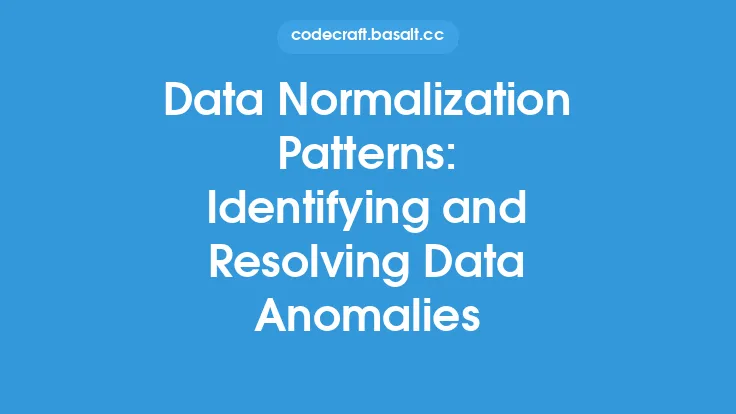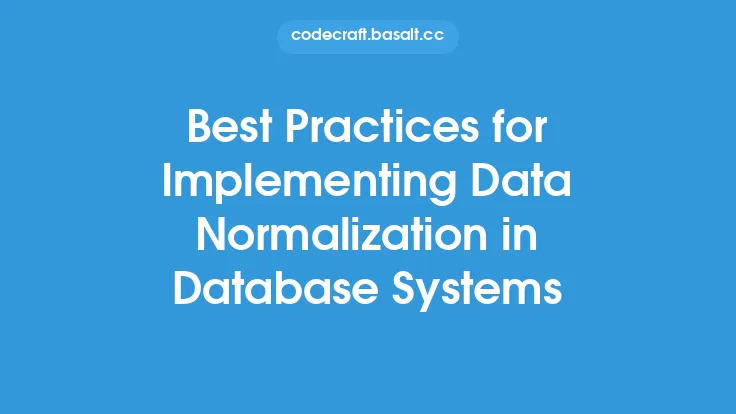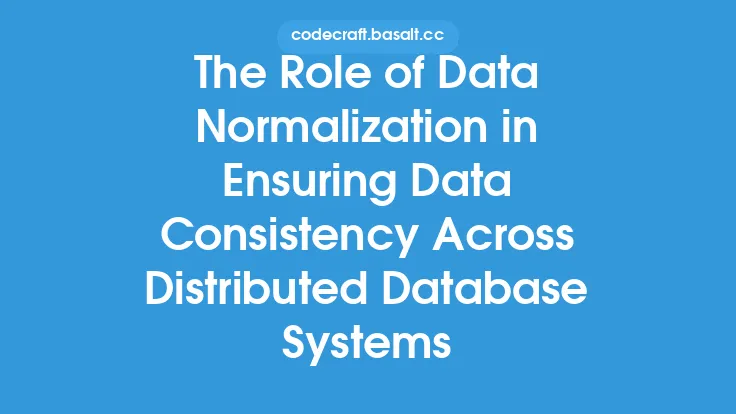In the realm of database systems, data normalization is a crucial process that ensures the integrity and consistency of data. It involves organizing data in a way that minimizes data redundancy and dependency, making it easier to maintain and scale. At the heart of data normalization are three fundamental forms: First Normal Form (1NF), Second Normal Form (2NF), and Third Normal Form (3NF). These forms provide a structured approach to normalizing data, each building upon the previous one to achieve higher levels of normalization.
Introduction to First Normal Form (1NF)
First Normal Form (1NF) is the most basic level of normalization, which states that each cell in a table must contain a single value. In other words, each column must have a unique value for each row. To achieve 1NF, a table must not have any repeating groups or arrays. For example, consider a table that stores customer information, including their name, address, and phone numbers. If the phone numbers are stored as an array or a comma-separated list, it would violate 1NF. Instead, each phone number should be stored in a separate row, with a unique identifier for each customer.
Understanding Second Normal Form (2NF)
Second Normal Form (2NF) builds upon 1NF by ensuring that each non-key attribute in a table depends on the entire primary key. In other words, if a table has a composite primary key (a key that consists of multiple columns), each non-key attribute must depend on all the columns that make up the primary key. To achieve 2NF, a table must be in 1NF, and each non-key attribute must be fully functional dependent on the primary key. For instance, consider a table that stores order information, including the order ID, customer ID, order date, and product ID. If the customer name is stored in this table, it would violate 2NF because the customer name depends only on the customer ID, not the entire primary key (order ID and customer ID).
Achieving Third Normal Form (3NF)
Third Normal Form (3NF) is the highest level of normalization, which states that if a table is in 2NF, and a non-key attribute depends on another non-key attribute, then it should be moved to a separate table. In other words, 3NF eliminates transitive dependencies, where a non-key attribute depends on another non-key attribute. To achieve 3NF, a table must be in 2NF, and each non-key attribute must depend only on the primary key. For example, consider a table that stores employee information, including their name, address, and department ID. If the department name is stored in this table, it would violate 3NF because the department name depends on the department ID, which is a non-key attribute. Instead, the department name should be stored in a separate table, with the department ID as the primary key.
Normalization Techniques
In addition to the three normal forms, there are other normalization techniques that can be used to further normalize data. These include:
- Boyce-Codd Normal Form (BCNF): This form states that a table is in BCNF if and only if it is in 3NF, and there are no transitive dependencies.
- Fourth Normal Form (4NF): This form states that a table is in 4NF if and only if it is in BCNF, and there are no multi-level dependencies.
- Fifth Normal Form (5NF): This form states that a table is in 5NF if and only if it is in 4NF, and there are no join dependencies.
Benefits of Data Normalization
Data normalization provides several benefits, including:
- Improved data integrity: Normalization ensures that data is consistent and accurate, reducing errors and inconsistencies.
- Reduced data redundancy: Normalization eliminates redundant data, reducing storage requirements and improving data management.
- Improved scalability: Normalization makes it easier to add new data or modify existing data, improving the overall scalability of the database.
- Improved data security: Normalization ensures that sensitive data is stored securely, reducing the risk of data breaches.
Challenges and Limitations
While data normalization provides several benefits, it also presents some challenges and limitations. These include:
- Increased complexity: Normalization can make the database more complex, requiring more tables and relationships.
- Performance overhead: Normalization can result in additional joins and queries, which can impact performance.
- Data fragmentation: Normalization can result in data fragmentation, where related data is stored in separate tables.
Best Practices
To ensure effective data normalization, follow these best practices:
- Start with a clear understanding of the data: Before normalizing data, ensure that you have a clear understanding of the data and its relationships.
- Use a structured approach: Use a structured approach to normalization, starting with 1NF and progressing to higher levels of normalization.
- Use indexing and constraints: Use indexing and constraints to improve data integrity and performance.
- Monitor and maintain the database: Regularly monitor and maintain the database to ensure that it remains normalized and optimized.
Conclusion
Data normalization is a critical process in database systems, ensuring the integrity and consistency of data. By understanding the three normal forms (1NF, 2NF, and 3NF) and using other normalization techniques, you can create a well-structured and scalable database. While data normalization presents some challenges and limitations, following best practices and using a structured approach can help ensure effective normalization and improved data management.





